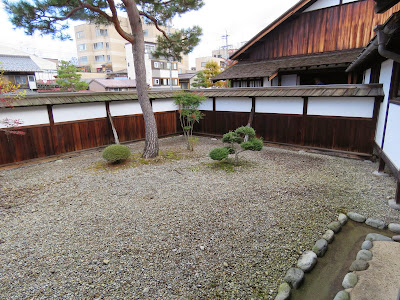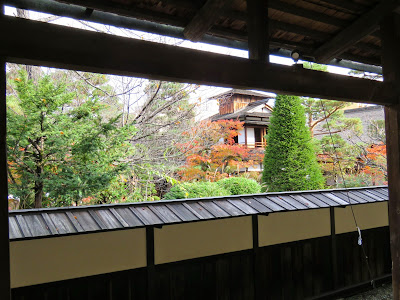
Takayama Jinya was the only local governor's office left from a total of 60 that had been scattered around Japan. It was an administrative office where district governors of Hida Region, worked and lived during Edo Period (1600-1868). The main duty of a district governor in the olden times, was to conduct legal trials and collect tax.


The front gate of Takayama Jinya was a symbolic architecture feature of Government offices built in year 1832. The complex includes a work area, residential space and store house. The crest of hollyhock on the screen and lantern was the indication mark for offices directly under the control of Edo Shogunate (1600-1868).



The Governor's office in Takayama was treated as an important section to central Government of Shognate at that time, as it had abundant forest resources producing high quality timbers, and underground natural resources of gold, silver, copper and lead.


Views of the courtyard garden from one of the rooms.



The landscaped garden at the central court became an eye-catching sight particularly during fall season when it was shaded in beautiful colors.



Who will ask for more when working and living environment are set in with such a beautiful landscape garden !















Buildings inside the whole complex were winded up with roofed walls.









The room of head officer is delicately arranged with an incense burner and hanged on the wall with a motivated calligraphic poem. The Grand Hall was the venue of public ceremonies and conferences. It was divided into three sections by sliding panels. The numbers of Tatami seats in the hall are 49, an extra one to the initial 48 to avoid even numbers that are related to hana-kiri (Cutting-belly). Material and design applied for the tatami differed from levels of people who used it. The fringed tatami were meant only for upper class officers.



Displayed in the exhibition hall, are many hand written documents in various style of Chinese calligraphy.



The elegant wooden sedan chair displayed in the Edo Government messengers room was specially meant for monks only. There are some punishment tools at Oshirasu criminal court that was used for civil cases.


The steel tea pot with device to adjust the length of hanging bar in the tea room is interesting. Boiling the kettle to have hot water to make tea and in the meantime, heat up the room in cold weather. The old rice cooking utensils with wooden covers are still used by some of the authentic restaurants in Japan.



Kitchen where meals were prepared for the upper level officers, their families and guests, was set up with little gaps on the wall panels as ventilation during cooking hours and in cold season, gaps were sealed up by miso paste. Besides cooking area, there was also a storage room in a slightly lower ground level where they prepared and stored fermented items like miso or pickles.


Simple hand made irrigation system was built at the corners of the building, and within the premises, there are beautiful hand washing area and neat old toilet.



The store house relocated from Takayama Castle, was the place to keep the rice as a form of tax contributed by inhabitants. The building that has an history of 400 years, used long shingles to make its roof holding up by stones without any nails. Displayed near the store house was a sample of ancient "Ghost Plank" roof sometimes used in the old buildings.


Chrysnthemum flowers blossom in autumn and are used to adorn places like Temples or Public buildings to attract admirers during fall season. Pots of Chrysnthemum in various species displayed at the back yard of Takayama Jinya are arranged into bonsai! Gorgeous!










This piece of wood bark has a face of an old man and the other one appears like a sexy lady.



The group of beautifully shaped flowers are normally used for decorations or ceremonies.



Three sizes of roof shingles were applied to various buildings of Takayama Jinya. The stores used long shingles, office and gate used medium size and short ones were applied only for its eaves and entrance.


No comments:
Post a Comment